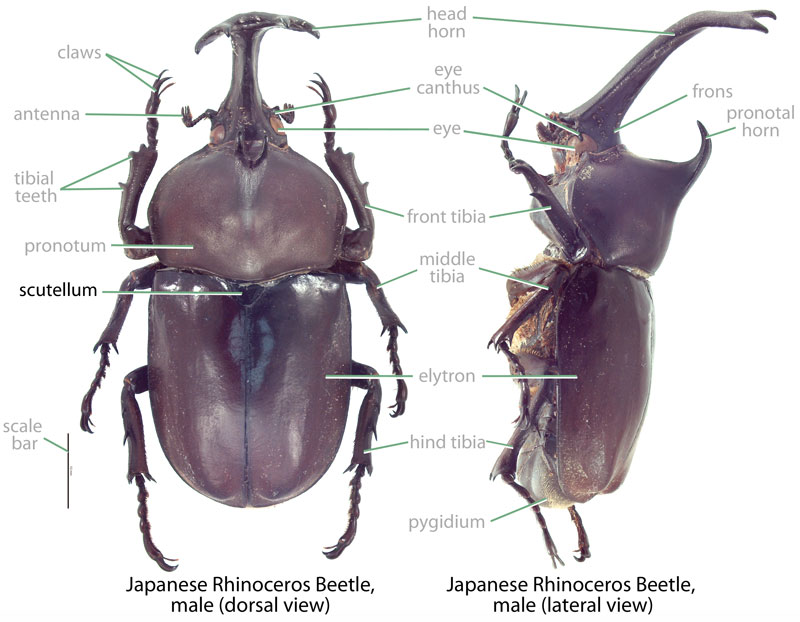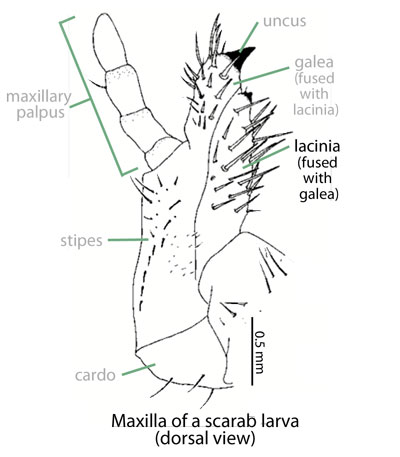Beneficial
none known
Family: Scarabaeidae Subfamily: Scarabaeinae Genus: Onthophagus Species: Onthophagus cuniculus MacLeay, 1864
none available
Total body length 7.0–12.0 mm (0.28–0.47 in). Body shape oval; may be covered in dung. Color of head and thorax bright metallic red-green; abdomen black. Small to medium-sized dung beetle, over 6 mm. Clypealclypeal:
of, or referring to, the clypeus
apexapex:
point or edge furthest from the body
of major male produced, strongly recurvedrecurved:
bending backwards
; minor male and female with apexapex:
point or edge furthest from the body
rounded or feebly sinuatesinuate:
gently curved (specifically of margins or edges); often in reference to the clypeus
, not strongly recurvedrecurved:
bending backwards
. Head of both sexes lacking horns; major male with pairedpaired:
in relation to bilateral symmetry: occurring on both sides of the body
tubercles near base; minor male and female with slightly curved ridge near base. Ocular canthuscanthus:
a process extending over and sometimes dividing the eye
completely dividing eye. Pronotumpronotum:
the dorsal surface of the thorax
 of major male with horn-like process; minor male and female with bi-lobedbi-lobed:
of major male with horn-like process; minor male and female with bi-lobedbi-lobed:
possessed of two lobe-like structures
process. Pronotumpronotum:
the dorsal surface of the thorax
 with anterioranterior:
with anterioranterior:
the front or forward; opposite of posterior
angles curved outward in both sexes. Front tibiatibia:
a segment of the leg articulated with the tarsus and femur
 of male slightly slender and elongate, female tibiatibia:
of male slightly slender and elongate, female tibiatibia:
a segment of the leg articulated with the tarsus and femur
 somewhat more robust. Scutellumscutellum:
somewhat more robust. Scutellumscutellum:
the triangular portion of the thorax between the bases of the elytra
 absent.
absent.
Undescribed. For Onthophagus spp. (Ritcher, 1966Ritcher, 1966:
Ritcher P. 1966. White grubs and their allies: a study of North American scarabaeoid larvae. Oregon State University Monographs, Studies in Entomology 4: 1-219.): Grub C-shaped, hump-backed, cylindrical, and cream-colored. Maxillamaxilla:
set of paired mouthparts located posterior to the mandibles
with galeagalea:
outer branch or lobe of the maxilla
 and lacinialacinia:
and lacinialacinia:
inner portion of the maxilla distinctly separate. Epipharynxepipharynx:
distinctly separate. Epipharynxepipharynx:
lobe on the interior surface of the labrum or clypeus
with tormaetormae:
in scarab larvae, sclerotized structures on the ends of the clypeolateral suture extending towards the mesal line
united mesallymesally:
at or near midline of body
, anterioranterior:
the front or forward; opposite of posterior
phoba present. AntennaeAntennae:
paired sensory organ on head, formed from numerous segments
 4-segmented, distaldistal:
4-segmented, distaldistal:
situated away from the point of articulation, thus usually furthest from the body
segment much reduced. Legs 2-segmented. Prothoracic shieldprothoracic shield:
the chitinous plate behind the head of larvae
 without anteriorly projecting processes. Third abdominal segment bearing a prominent conical, dorsaldorsal:
without anteriorly projecting processes. Third abdominal segment bearing a prominent conical, dorsaldorsal:
of or relating to the upper surface; opposite of ventral
gibbosity covered with numerous short, stout setaesetae:
small, hair-like structure
.
Australia. This species is known from Queensland Australia, where it occurs between the Atherton Tablelands and the Tropic of Capricorn (Matthews, 1972Matthews, 1972:
Matthews E. 1972. A revision of the Scarabaeine dung beetles of Australia. I. Tribe Onthophagini. Australian Journal of Zoology Supplementary Series 19: 3-330.).
None. This species feeds on dung as both an adult and larvalarva:
the immature form of an insect; in scarabs, also called grub or white grub; preceded by the egg stage, followed by the pupal stage
 . There are no records of this beetle feeding on live plant tissues.
. There are no records of this beetle feeding on live plant tissues.
This diurnaldiurnal:
active during daylight hours
species has been found on cattle and human dung, it is also known to feed on carrion (Matthews, 1972Matthews, 1972:
Matthews E. 1972. A revision of the Scarabaeine dung beetles of Australia. I. Tribe Onthophagini. Australian Journal of Zoology Supplementary Series 19: 3-330.). It can be found in savannahs and open woodlands where annual rainfall exceedes 127 cm (50 in). Life history of the species is poorly known, but related Onthophagus species are dung tunnelers, with females creating a burrow under or near dung (Woodruff, 1973Woodruff, 1973:
Woodruff R. 1973. The scarab beetles of Florida (Coleoptera: Scarabaeidae) part I. The Laparosticti (Subfamilies: Scarabaeinae, Aphodiinae, Hybosorinae, Ochodaeinae, Geotrupinae, Acanthocerinae). Arthropods of Florida and Neighboring Land Areas 8: 1-220.). The burrow is then provisioned with dung in the form of brood balls. Each ball is impregnated with an egg; larval development occurs within the brood ball.
None. This species recycles dung and is beneficial for ranching and farming in Hawaii. Primarily being a dung feeder, this species has never been recorded damaging crop or ornamental plants. Additionally, this species is not a threat to native dung beetles because none occur in Hawaii or Guam.
Recorded, not established. This species was intentionally brought to Hawaii in 1921, though it is unclear if any individuals were released (Hawaii Division of Forestry, 1923Hawaii Division of Forestry, 1923:
Anonymous. 1923. Report of the entomologist. Hawaii Board of Commissioners of Agriculture and Forestry. Division of Forestry. Honolulu, HI: Hawaiian Gazette Company.). Similar dung beetle introductions were undertaken to help control populations of the horn fly (Haematobia irritans), a biting pest of livestock (Markin and Yoshioka, 1998Markin and Yoshioka, 1998:
Markin G and Yoshioka E. 1998. Biological control of the horn fly, Haematobia irritans L., in Hawai'i (Diptera: Muscidae). Proceedings of the Hawaiian Entomological Society 33: 43-50. full text (accessed 2015)). If this species was released, it failed to establish populations in the state (Nishida, 2002Nishida, 2002:
Nishida G (editor). 2002. Hawaiian terrestrial arthropod checklist, fourth edition. Bishop Museum Technical Report 22: 1-313.).
Not established or recorded. There are no records of this species from Guam.
In Hawaii, this species was intentionally imported.
This dung beetle could be confused with similarly colored, small to medium-sized (more than 6 mm) Onthophagus species such as Onthophagus binodis, Onthophagus incensus, Onthophagus laminatus, Onthophagus armatus, and Onthophagus comperei.
Major males of these species can be distinguished by examining the head armature (O. cuniculus has pairedpaired:
in relation to bilateral symmetry: occurring on both sides of the body
tubercles versus O. incensus, O. laminatus, O. armatus, and O. comperei all with head horns versus O. binodis lacking horns).
Females are somewhat more difficult to distinguish, but nonetheless can be separated by examining the base of the head (O. cuniculus with a slightly curved ridge versus O. armatus with a feebly bisinuatebisinuate:
possessing two sinuate edges or portions, with two curves
ridge and O. compereiwith 2 tubercles), pronotal process (O. cuniculus with a bi-lobedbi-lobed:
possessed of two lobe-like structures
process versus O. binodis and O. laminatus with a small lobe-like process versus O. incensus, O. armatus, and O. comperei lacking a pronotal process) and anterioranterior:
the front or forward; opposite of posterior
angle of the pronotumpronotum:
the dorsal surface of the thorax
 (O. cuniculus with anterioranterior:
(O. cuniculus with anterioranterior:
the front or forward; opposite of posterior
angles curved outward versus O. binodis, O. incensus, O. armatus, and O. comperei with anterioranterior:
the front or forward; opposite of posterior
angles rounded).
none known
Report your observation of this beneficial species at our iNaturalist project.